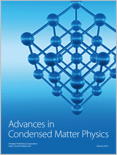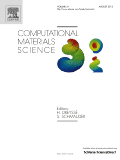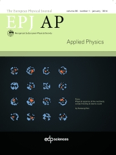
Advances in Condensed Matter Physics
Scope & Guideline
Pioneering Theoretical and Experimental Advances
Introduction
Aims and Scopes
- Theoretical and Computational Studies:
The journal emphasizes the use of theoretical frameworks and computational methods, such as first-principles calculations and density functional theory (DFT), to investigate the structural, electronic, and optical properties of materials. - Nanostructures and Nanomaterials:
Research on the synthesis, characterization, and application of nanostructures, including quantum dots, nanocomposites, and thin films, is a core focus area, particularly in relation to their electronic and optical properties. - Magnetism and Spintronics:
The journal features studies on magnetic materials and spintronic devices, exploring phenomena such as ferromagnetism, half-metallicity, and the interplay between magnetism and superconductivity. - Optoelectronics and Energy Applications:
Investigations into materials for optoelectronic applications, including photovoltaics and photodetectors, as well as materials for energy storage and conversion, are prominently featured. - Multiferroics and Functional Materials:
The exploration of multiferroic materials and their functionalities, including their mechanical, thermal, and electromagnetic properties, is a significant aspect of the journal's publication.
Trending and Emerging
- Advanced Characterization Techniques:
There is a growing trend towards the use of advanced characterization techniques, such as in-situ measurements and spectroscopy, to gain deeper insights into the properties of materials at nanoscale dimensions. - Computational Materials Science:
An increasing emphasis on computational approaches to materials science, including machine learning and artificial intelligence applications in predicting material properties, is becoming evident. - Sustainable and Green Materials:
Research focusing on sustainable and environmentally friendly materials, including biodegradable and recyclable materials, is gaining traction, reflecting a broader societal shift towards sustainability in technology. - Hybrid and Composite Materials:
The development and study of hybrid and composite materials that combine the properties of different materials to achieve enhanced performance in applications like energy storage and conversion are emerging as a significant theme. - Quantum Technologies:
Interest in quantum technologies, particularly in relation to quantum computing and quantum communication, is on the rise, with research exploring new materials that can facilitate these technologies.
Declining or Waning
- Organic Materials:
Research on organic materials and their properties has decreased, potentially due to a shift towards more robust inorganic materials and nanostructures that offer superior performance in applications. - Low-Dimensional Systems:
The focus on low-dimensional systems, such as one-dimensional nanowires or two-dimensional materials beyond graphene, appears to be waning, possibly as the field matures and researchers move toward more complex heterostructures. - Thermal Properties of Materials:
Studies specifically targeting the thermal properties of materials, although still relevant, have become less frequent, indicating a potential shift towards more comprehensive investigations that integrate thermal behavior with other material characteristics.
Similar Journals

Computational Condensed Matter
Delivering Cutting-Edge Research in Computational PhysicsComputational Condensed Matter, a reputable journal published by Elsevier, serves as a critical platform for advancing the understanding of condensed matter physics and related fields. Since its inception in 2014, the journal has become a pivotal resource for researchers and professionals dedicated to exploring electronic, optical, and magnetic materials, as well as materials chemistry and general materials science. With its current standing in the Q3 quartile across multiple categories in 2023, it ranks within the 60th percentile for Materials Science (miscellaneous) and the 54th percentile for Condensed Matter Physics in Scopus, reflecting its growing influence and relevance in the scientific community. The journal aims to publish high-quality, peer-reviewed articles that can foster innovation and collaboration in computational methods applied to condensed matter systems. Researchers interested in cutting-edge insights and methodologies will find Computational Condensed Matter to be an invaluable addition to their academic resources. For those seeking to contribute to or stay informed about the latest advancements in the field, this journal is a must-read.

PHYSICS OF THE SOLID STATE
Pioneering Discoveries in Solid-State PhysicsPhysics of the Solid State is a distinguished journal published by Pleiades Publishing Inc., focusing on the rapid advancements and fundamental research in the realms of condensed matter physics, electronic, optical, and magnetic materials. With an ISSN of 1063-7834 and an E-ISSN of 1090-6460, this journal serves as a crucial platform for disseminating high-quality research findings, insights, and reviews essential for both academic and industrial professionals in the field. As of 2023, its Scopus ranking places it in the 26th percentile for both Condensed Matter Physics and Electronic, Optical and Magnetic Materials, reflecting its evolving influence and contribution to the scientific community. Although currently classified in the Q4 quartile, the journal aims to foster interdisciplinary dialogue, improve research visibility, and enhance its impact on contemporary scientific challenges through rigorous peer-reviewed articles and focused special issues. Despite its traditional model of access, it continues to play a pivotal role in engaging researchers and fostering innovation in solid-state physics.

Journal of Ovonic Research
Advancing the Frontiers of Material Science.Journal of Ovonic Research is a distinguished publication dedicated to advancing the fields of electronic, optical, and magnetic materials. Published by VIRTUAL CO PHYSICS SRL, this journal offers a platform for researchers to share innovative findings and developments that push the boundaries of technology and materials science. With an ISSN of 1842-2403 and an E-ISSN of 1584-9953, it provides an important service to the academic community, particularly within Romania and beyond. Despite its recent inception in 2011, the journal has gained traction in the academic landscape, reflecting a Q4 quartile ranking in crucial categories such as Electronic, Optical and Magnetic Materials, as well as in Physics and Astronomy. The Scopus rankings further underscore its positioning, ranking within the 25th to 37th percentile across various disciplines, making it a valuable resource for professionals and students alike. Although the journal currently operates on a non-open access basis, it remains committed to exploring the latest advancements in materials science, encouraging interdisciplinary collaboration and fostering a deeper understanding of surface, coating, and film technologies. As the field evolves, Journal of Ovonic Research stands as a beacon for scholarly communication, bridging the gap between research and practical application.

npj Quantum Materials
Advancing Knowledge in Quantum Technologiesnpj Quantum Materials is a premier, peer-reviewed academic journal published by NATURE PORTFOLIO, focusing on the transformative field of quantum materials. Launched in 2016, this open-access journal aims to bridge the gap between theoretical advances and experimental discoveries, providing a platform for researchers to share cutting-edge findings in condensed matter physics and materials science. With a prestigious Q1 ranking in both Condensed Matter Physics and Electronic, Optical and Magnetic Materials, it stands out in its field, boasting impressive Scopus rankings—#34 out of 434 in Condensed Matter Physics and #39 out of 284 in Electronic, Optical and Magnetic Materials, putting it in the 92nd and 86th percentiles, respectively. The journal emphasizes collaborative efforts that drive innovation and application in quantum technologies, making it an essential resource for researchers, professionals, and students eager to contribute to this rapidly evolving discipline. Accessible to a global audience, npj Quantum Materials continues to shape the future of quantum research through its high-quality publications and community engagement.

Science China-Physics Mechanics & Astronomy
Connecting Global Minds Through Open Access ScienceScience China-Physics Mechanics & Astronomy, published by SCIENCE PRESS, stands as a prestigious journal within the Physics and Astronomy domain, particularly recognized for its contributions to the understanding of fundamental and applied physics. With an exhilarating Q1 ranking in the 2023 category and earning a remarkable scopus rank of #21 out of 243, the journal demonstrates its significant impact, being positioned in the 91st percentile of its field. Operating under an Open Access model, it facilitates the broad dissemination of high-quality research, ensuring accessibility for researchers, professionals, and students worldwide. Its scope covers a variety of essential topics in physics and astronomy, promoting a comprehensive understanding of the latest advancements from 2010 through 2024. The journal is a vital resource for anyone aiming to stay at the forefront of research in these dynamic fields, with its prominent address located in Beijing, China, symbolizing its global influence.

Journal of Physics-Materials
Connecting Researchers for a Sustainable FutureJournal of Physics-Materials, published by IOP Publishing Ltd, serves as a leading platform for disseminating groundbreaking research in the realms of Atomic and Molecular Physics, Condensed Matter Physics, and Materials Science. This Open Access journal, established in 2018, enables wide-reaching visibility and accessibility to high-impact studies, fostering international collaboration and innovation within the scientific community. With a remarkable Q1 ranking in prestigious categories and impressive Scopus rankings—positioned at #38 in Condensed Matter Physics and #29 in Atomic and Molecular Physics—this journal plays a pivotal role in shaping contemporary research and discussions in physics and materials science. Researchers, students, and professionals alike are encouraged to contribute to and engage with the rich knowledge base this journal offers, which is dedicated to advancing the frontier of materials research and its numerous applications.

COMPUTATIONAL MATERIALS SCIENCE
Unleashing the Power of Computational InsightsCOMPUTATIONAL MATERIALS SCIENCE is a prestigious academic journal dedicated to the dissemination of innovative research in the field of computational materials science, emphasizing the interplay between computational methodologies and materials engineering. Published by ELSEVIER in the Netherlands, this journal showcases high-impact articles that contribute significantly to the understanding of material properties through computational techniques. As evidenced by its 2023 Scopus Rankings, which place it in the top quartiles across multiple disciplines including Computer Science, Materials Science, and Physics and Astronomy, it is a vital resource for researchers, professionals, and students alike. With a focus on advancing scientific knowledge and practical applications, COMPUTATIONAL MATERIALS SCIENCE aims to bridge the gap between theoretical investigations and experimental validation. Explore a wealth of cutting-edge research designed to inspire the next generation of innovations in materials science through this esteemed publication.

PHYSICA SCRIPTA
Innovating Insights in Atomic and Molecular PhysicsPHYSICA SCRIPTA, established in 1970 and published by IOP Publishing Ltd, is a prestigious journal dedicated to the broad fields of physics, encompassing topics such as atomic and molecular physics, condensed matter physics, and mathematical physics. With an impressive commitment to advancing scientific knowledge, it holds a significant standing in the academic community, evidenced by its Q2 and Q3 rankings across various categories in 2023. The journal is instrumental for researchers, professionals, and students seeking to disseminate and engage with high-quality research, fostering collaboration and innovation within the field. Although it currently does not offer open access options, its robust editorial standards ensure the dissemination of impactful studies, contributing to its rising citation metrics. Published from the United Kingdom, PHYSICA SCRIPTA continues to be a vital resource for contemporary developments in physics, paving the way for future discoveries.

EUROPEAN PHYSICAL JOURNAL-APPLIED PHYSICS
Advancing the Frontiers of Applied PhysicsEUROPEAN PHYSICAL JOURNAL-APPLIED PHYSICS, published by EDP SCIENCES S A in France, serves as a vital platform for the dissemination of cutting-edge research in the fields of condensed matter physics, electronic, optical and magnetic materials, and instrumentation. With an ISSN of 1286-0042 and E-ISSN of 1286-0050, this journal has been a valuable resource for researchers since its inception in 1998, aiming to foster innovation and dialogue among professionals and academics alike. Featuring an impact factor that reflects its growing influence, the journal is currently ranked in the Q4 quartile for several related categories in 2023, underscoring its ongoing contributions to the scientific community despite its relatively competitive positioning. Access to the journal is available through various Open Access options, ensuring that pioneering research is readily accessible to all. As it continues to evolve towards its 2024 objectives, EUROPEAN PHYSICAL JOURNAL-APPLIED PHYSICS remains dedicated to advancing knowledge and facilitating collaboration in applied physics, making it an essential resource for students, researchers, and professionals dedicated to exploring the forefront of physical sciences.

JETP LETTERS
Empowering Researchers to Shape the Future of PhysicsJETP LETTERS, published by MAIK NAUKA/INTERPERIODICA/SPRINGER, is a prestigious journal in the field of physics and astronomy, which plays a pivotal role in disseminating groundbreaking research and innovative ideas since its inception in 1969. With an ISSN of 0021-3640 and an E-ISSN of 1090-6487, this journal aligns well with the interests of both seasoned researchers and emerging scholars, having achieved a 2023 category rank of Q3 for miscellaneous topics within physics and astronomy. Located in the United States at 233 SPRING ST, NEW YORK, NY 10013-1578, JETP LETTERS serves as a critical resource for its readership, offering exclusive insights and advancements across diverse areas of physics. While not open access, it hosts a collection of articles that refine theoretical approaches and experimental methods, providing both knowledge and inspiration to professionals and academics seeking to make impactful contributions to the scientific community. The journal’s quality is reflected in its Scopus ranking, where it stands at 39 out of 81 in the multidisciplinary category, placing it in the 52nd percentile, thus underscoring its significance and reliability as a scholarly outlet.